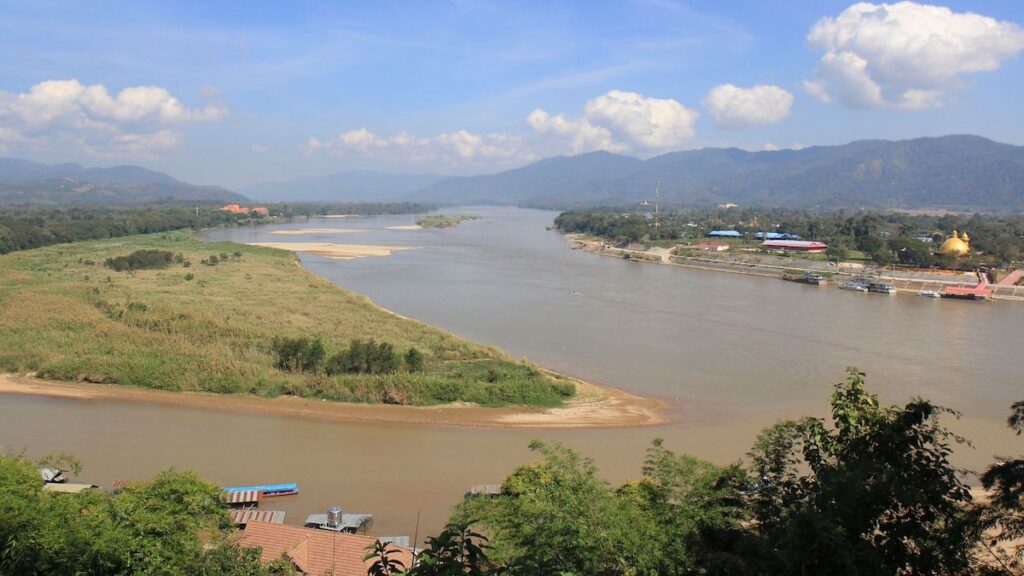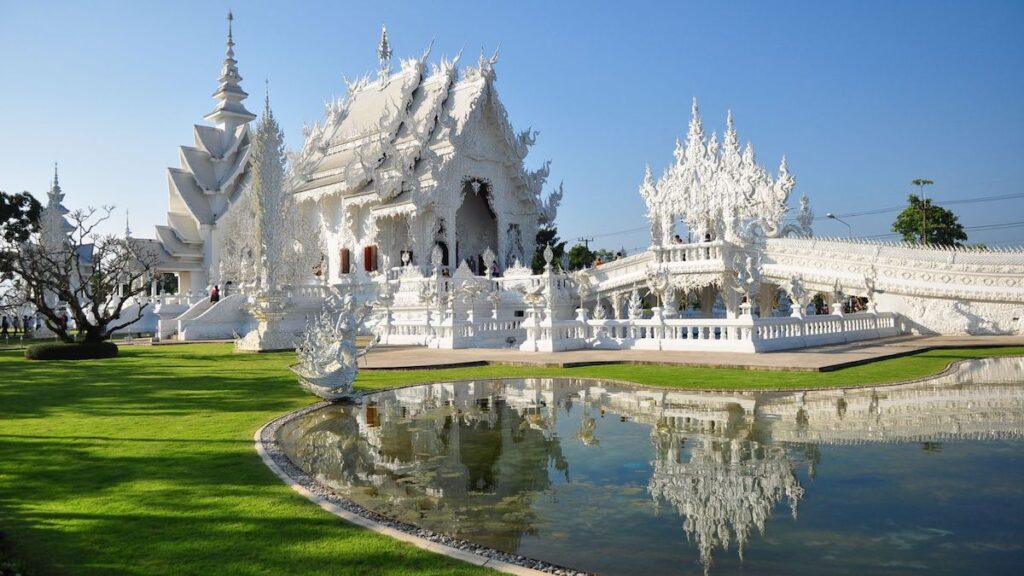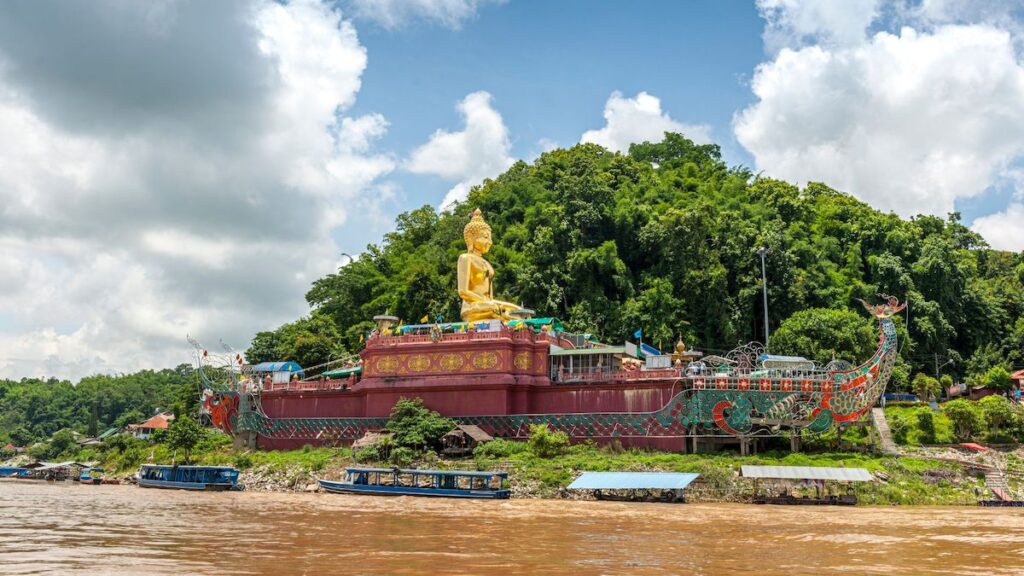Golden Triangle Thailand
Coined by an unnamed CIA officer working in the area in the 1970s, the title Golden Triangle refers to a 350,000 km2 area covering the mountainous regions of Myanmar, Laos, and Thailand. The ‘triangle’ in particular was famous for drugs growing and, although the fields of poppies are long gone, the name has stuck and the small riverside town of Sop Ruak has become the focus of this legend.
Today, it is a tourist destination better known as the point where the borders of Thailand, Myanmar, and Laos intersect. The actual point is in fact the confluence of the mighty Mekong and lesser-known Ruak rivers in Thailand’s northernmost point. You’re more likely to find souvenir sellers, gamblers, and busloads of camera-toting tourists here than any drug dens, but there is still plenty of interest in the area to make a short trip here from Chiang Rai worthwhile.
 Golden Triangle Guide
Golden Triangle Guide
Thailand’s Golden Triangle region is in Chiang Rai province and includes Chiang Rai city as well as towns such as Mae Sai and Chiang Saen. Each of these destinations has its own attractions; however, the historic riverside town of Chiang Saen – the oldest significant settlement in Northern Thailand – seems to be the focus of the Golden Triangle. The focus of the triangle is the small but touristy riverside town of Sop Ruak, some 10kms north. Here you’ll find the excellent Hall museum.
Chiang Rai is the largest and only city in the area, located a 45-minute drive from the Golden Triangle proper. This unremarkable town has some limited historic interest, but the best infrastructure and hotel selection in the far north. From here you can go trekking, visit hill-tribe villages, ride elephants and make day trips to the lofty Doi Tung Royal Villa and Mae Fah Luang Botanical Garden. It’s also possible to hop over the border to the Burmese town of Tachilek for some shopping and cheap Chinese goods. Also within easy reach is the tea-growing Chinese community in the hamlet of Mae Salong, which boasts gorgeous views.
There are fairly good accommodation options at all of the main tourist centers in the Golden Triangle region, with everything from backpacker budget establishments to quality resorts and hotels. Several transportation options make getting around fairly easy and increase the appeal of the area, which is commonly visited as a short trip from the large city of Chiang Mai.
Golden Triangle Tourist Attractions And Activities
The town of Chiang Saen is the focal point of the Golden Triangle from a tourist perspective. Besides offering its own impressive selection of historic attractions, it is within easy access to the attractions of Chiang Rai, Mae Sai, and everything in between. The area is home to a small selection of quality resorts at which visitors can avail themselves of services such as Thai massage and other spa treatments as well as quality dining facilities. The actual ‘triangle’ point is located in the small town of Sop Ruak, 10 km to the north.
Golden Triangle Viewpoint
 There are various points from which to observe the meeting point of Thailand, Myanmar, and Laos; however, the best is perhaps at Sop Ruak to the northwest of Chiang Saen.
There are various points from which to observe the meeting point of Thailand, Myanmar, and Laos; however, the best is perhaps at Sop Ruak to the northwest of Chiang Saen.
This is considered the official viewpoint and comes complete with a sign to indicate such, which visitors can use as a fitting background for that obligatory photograph.
There is a good selection of vendors cashing in on the tourist traffic, selling Thai and Burmese goods which make for ideal souvenirs or gifts to take home.
Old Museum
Located in the center of Chiang Saen, this popular museum gives visitors an insight into the drug trade that was once rife in the Golden Triangle region, focusing on how it flourished and was eventually controlled. Sections of the museum concentrate on the early global history, the 19th-century drug wars, and the 20th-century trafficking problem in Southeast Asia. It has been upstaged by the world-class Hall nearby but is a much cheaper alternative.
Hall of Golden Triangle
Completed in 2005 at the cost of US$10 million, this exceptional museum ranks as one of the best in the region. Built with foreign input, it’s an excellent interactive tour de force through the history of drugs. There are brilliant multi-media exhibits telling all there is to know about this narcotic which shaped the course of history significantly in Asia. Well worth the entrance fee.
Chiang Saen National Museum
Located close to Wat Chedi Luang in Chiang Saen, this impressive museum is home to a variety of artifacts excavated in and around the area, with some pieces dating back to the time of the earliest settlers. Jewellery, Buddha icons, and masks are among the more notable pieces, while the stone reliefs that originally resided in Wat Sang Kha Kaew Don Tun are also of interest.
Wat Rong Khun
 Located just a short distance from the center of Chiang Rai, Wat Rong Khun is an ornately-decorated Thai temple covered from top to bottom in tiny mirrored tiles. This gives it an essentially white appearance while also causing it to glisten and sparkle in the sunlight. The temple owes its unusual appearance to Thai artist Chaleumchai Kositpipat who considers it a work in progress and constantly adds to the aesthetic appeal of the structure and the grounds in which it resides. It is a favorite venue for high society weddings.
Located just a short distance from the center of Chiang Rai, Wat Rong Khun is an ornately-decorated Thai temple covered from top to bottom in tiny mirrored tiles. This gives it an essentially white appearance while also causing it to glisten and sparkle in the sunlight. The temple owes its unusual appearance to Thai artist Chaleumchai Kositpipat who considers it a work in progress and constantly adds to the aesthetic appeal of the structure and the grounds in which it resides. It is a favorite venue for high society weddings.
Donsao Island
From Chiang Saen, it’s possible to take a short boat ride across the Mekong River to an island that is officially in Laotian territory. The landmass is small and only appealing from the perspective that visitors get the chance to say they’ve ‘visited’ Laos. A collection of shops on the island sells Laotian handicrafts, beer, whisky, and edible items.
Golden Triangle Temples
As is typical of any area in Thailand, the Golden Triangle is home to a good selection of traditional Buddhist temples featuring gilded exteriors and interiors with a variety of interesting Buddhist icons. Wat Chedi Luang is especially notable, dating as far back as the 13th century and featuring a 16th-century chedi. Also of note is Wat Phra That Chom Kitti, which dates back to the 10th century and features a chedi with a bronze-covered spire and some interesting Lopburi-style Buddha statues.
Mekong River Trips
 Visitors can take a trip along the Mekong River from Chiang Saen to Chiang Khong, taking in the views of both Thailand and Laos en route. Trips are three hours each way and cover a 20 km stretch of the river which cuts through jungle and mountain gorges. Trips are best made in the cool and hot seasons since the weather in the rainy season can make river conditions perilous.
Visitors can take a trip along the Mekong River from Chiang Saen to Chiang Khong, taking in the views of both Thailand and Laos en route. Trips are three hours each way and cover a 20 km stretch of the river which cuts through jungle and mountain gorges. Trips are best made in the cool and hot seasons since the weather in the rainy season can make river conditions perilous.
Mae Sai – Tachilek
Half an hour’s journey beyond Chiang Rai brings you to the Thailand-Myanmar border, with the town of Mae Sai on the Thai side and Tachilek on the Burmese. Surrender your passport and get a one-day pass into Tachilek where a veritable emporium of cheap pirated CDs and DVDs, fake designer goods, electronic products, edible items, and handmade goods await.
It’s possible also to take short tours of the area around Tachilek, visiting temples and other local sites of interest. Tours can be arranged with any of the many hawkers waiting at the top of the stairs to Tachilek’s market. On the Thai side of the border, there is more shopping but generally at higher prices.
Doi Tung Royal Villa and Mae Fah Luang Gardens
There are several reasons to ascend this striking 1,800-metre-high mountain along the border, just west of the Mae Sai crossing post. A good but windy road takes you up to several attractions, the oldest of which are two ancient chedi dating from the 10th century – a popular pilgrimage site. Continuing up the mountain, you can visit the Royal Villa, now a museum honoring the present king’s late mother who would retreat here and was responsible for the eradication of drug cultivation and agricultural substitution of the local hill tribes.
 There are some lovely landscaped gardens here too and a small zoo is also found on the premises. A hair-raising road descends the back of the mountain into Mae Sai, right on the actual border and with spectacular views, although it’s frequently closed if the usual Thai-Burmese border spats are going on. Drive it with extreme caution and do not leave your vehicle (if you step out on the left side of your vehicle, you will be in Myanmar, and it drops away very steeply).
There are some lovely landscaped gardens here too and a small zoo is also found on the premises. A hair-raising road descends the back of the mountain into Mae Sai, right on the actual border and with spectacular views, although it’s frequently closed if the usual Thai-Burmese border spats are going on. Drive it with extreme caution and do not leave your vehicle (if you step out on the left side of your vehicle, you will be in Myanmar, and it drops away very steeply).
Best Way to Get Around
Exploring the famous Golden Triangle at the border of Thailand, Laos, and Myanmar is a popular activity for tourists. But to really take in all the beauty and history of this area, there’s no better way than by boat. Renting out boats from Sop Ruak is an easy and convenient way for tourists to experience the area up close. With a 20-minute ride from Sop Ruak, you can be admiring the different scenes of the Golden Triangle from your own personal vessel. If you have a bit more time, you can explore further – head over to neighboring Chiang Saen for 40 minutes or Chiang Khong for 1 and a half hours!
How to Get to the Golden Triangle
Situated in the far north of Thailand, the Golden Triangle is easily accessed from Chiang Mai, the nation’s second-biggest city and major transport hub. From Bangkok, air travel is the most convenient option if you are not traveling on a budget, with the road journey from the capital being lengthy. Once in the region, transportation between key locations is easily done by bus, taxi, motorbike taxi, or songthaew, but a rented car might be most practical.
Chiang Rai Airport
Chiang Rai Airport is a small facility with a single terminal, located just eight kilometers from the center of Chiang Rai. The airport has the capability of serving international flights, but currently only offers domestic services to Chiang Mai and Bangkok.
Daily services are operated by Thai Airways and AirAsia. There are several flights per day from Bangkok Suvarnabhumi, while a single flight connects with Chiang Mai (through Thai Airways’ Thai Smile).
From outside the airport, passengers can hire regular taxis or tuk-tuks to take them either to the city center or the bus station or as far as Chiang Saen or Mae Sai.
Visitors booked to stay at one of Chiang Rai or Chiang Saen’s reputable resorts may well be offered a hotel pickup, either as a gratuity or for a fee.
Bus Transportation to the Golden Triangle
Buses run to Chiang Rai, with the journey taking 11-12 hours and bypassing Chiang Mai. Passengers wishing to travel to Mae Sai or Chiang Saen can take a connecting service – an extra 45-minute journey. From Chiang Mai, there are buses directly to Chiang Rai (three hours) and Chiang Saen (four hours, 30 minutes), and services to Mae Sai via Chiang Rai (four hours).
These buses leave hourly from the main bus terminal east of the city, though you may have to change in Chiang Rai to reach your final destination. Several guesthouses and travel agents also offer direct minibusses to Chiang Kong (for the boat ride along the Mekong to Luang Prabang in Laos) or to Mae Sai for visa runs.
Golden Triangle Car Transportation
The route to the Golden Triangle from Chiang Mai and northern Thai destinations is simple enough, although some of the routes pass through mountainous terrain and motorists should be alert for dangerous drivers. There are plenty of signposts in English to assist foreign visitors. Those bound for Chiang Saen need to turn right off the main highway, but this turning is well-signed and difficult to miss. From Chiang Rai to Mae Sai, the route is uncomplicated with plentiful signs as you head north.
Golden Triangle Public Transportation
Once in the Golden Triangle region, visitors can move between Chiang Rai, Chiang Saen, and Mae Sai via public bus. Songthaew (covered pick-ups) provides transportation for short distances and can be hailed in the street or accessed at strategic locations. Motorbike taxis, recognizable by the driver’s orange vest, are also available from selected locations for short journeys about town. Since distances are short, there are vehicles leaving more than once per hour from the bus terminal in the city center.
Bike And Car Hire In The Golden Triangle
Renting a vehicle gives visitors the chance to better explore the area and get a greater appreciation of its natural beauty. Between Chiang Mai and Mae Sai, there are myriad opportunities to veer off the main road and discover small villages and traditional rural areas as well as to find resorts and interesting dining establishments.
Car hire is available in Chiang Rai at more reasonable prices than in Chiang Mai, although visitors must leave their passports with the rental company unless they require them to cross the Thai-Burmese border. For car hire, we recommend online booking in advance.
Motorbikes are also available and, while they have a greater potential for hazard, they are considerably cheaper than cars. Most bikes are step-through or automatic models which are ideal for novice riders, although larger clutch-controlled versions are also available. Motorcycles are suitable for getting from Chiang Rai to Mae Sai or Chiang Saen/Sop Ruak, but only the brave should attempt riding from Chiang Mai to Chiang Rai on a rented bike as the traffic is dangerous.

